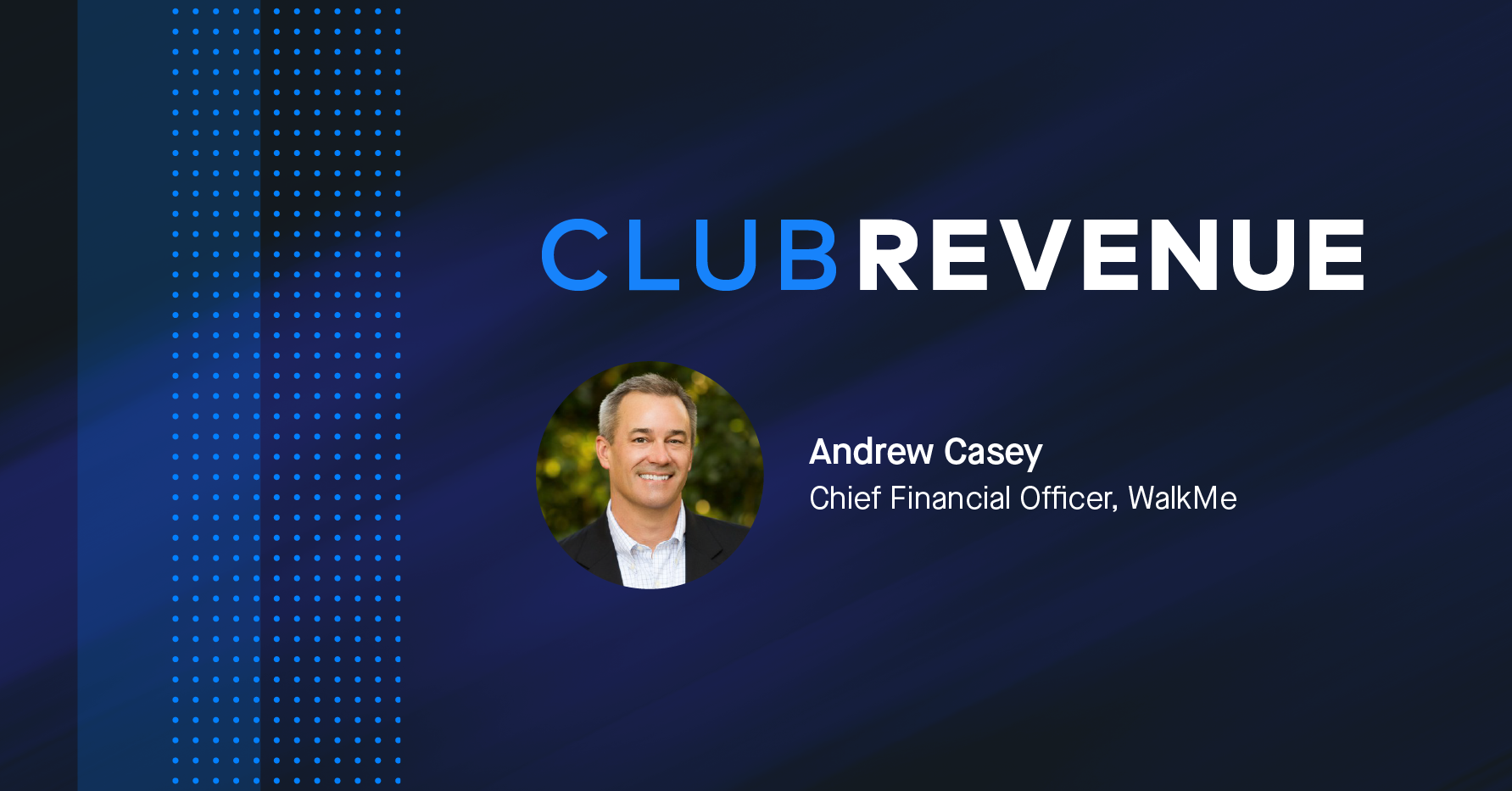Earning the confidence of investors for an initial public offering requires a new level of rigor around every process—every detail of the revenue process has to be perfect. Go-to-market teams bear the brunt of this, as their execution determines the value of the offering.
WalkMe CFO Andrew Casey prepped the digital adoption technology leader for its June 2021 IPO by aligning teams around a set of tightly defined growth metrics, and then embedding those metrics deep into the machinery of the organization. At Clari, we call them SGIs—strategic growth initiatives. Whatever the nomenclature, the goal is the same—achieving alignment for growth.
1. Align on a shared vision of success
The first step in operationalizing growth is to agree on a shared definition of success, Casey says.
The rubber meets the road when you define the metrics you’re tracking and why. As a modern SaaS platform, annual recurring revenue was the core focus for every piece of the business.
Whether measuring per customer, or per contract, “it just permeates everything that we do,” Casey says. “We had to make sure that the growth objectives were articulated in that net-new ARR level, because that will be how we are measured from a growth perspective, externally.”
Other key indicators they tracked to drive growth: net dollar retention, new logos, and free cash flow.
2. Cascade those success metrics down the revenue organization
Once he had alignment around key measures of success, Casey worked on operationalizing those measures, namely cascading them down into the compensation structure of revenue teams.
“From a sales perspective, you can do a lot of instrumentation and measurement to drive behaviors the way you want,” he says. “Sales reps, especially enterprise software sales, are very motivated by their compensation and so our architecture around our sales compensation was very much a product of the strategy that we want to put in place.”
He moved away from a quota system for his sellers, which was based on new, recurring, and expansion revenue, and shifted to a more holistic metrics system aligned with the company-wide indicators, like net-new ARR and dollar-based net retention.
“Before, we had a very siloed quota basis,” he says. “I think that’s fine for a very mature organization that can segment the resources and has very developed processes. But when you don’t have those things, and you’re asking the rep to be the key conduit back to the customer for all things, and they’re responsible for that account, then they’ve got to have a more holistic measurement architecture.”
3. Measure non-sales teams with the same metrics
Compensation incentives for Revenue teams outside of traditional sales were aligned to top-level company KPIs, too.
Every employee, including those on the marketing team and customer support, had a bonus program tied back to those four core measures of success: ARR, NDR, new logos, and cash flow.
Free cash flow was the most unusual one for employees who hadn’t worked in a public company before, but this metric turned out to be one of the most effective in helping people buy into the public company mindset. It gave them a way to measure everyday decisions against the big picture that investors would use to evaluate WalkMe.
With this metric in place, team members could ask themselves: How does this affect our ability to generate cash? How are you going to see a return on the investment you are asking the company to make?
For a sales leader, the question might relate to headcount. But it works for a marketer like myself as well. Before I sign off on a program like Club Revenue, I need to weigh the potential payoff in terms of authority, category, and pipeline.
“They really understand now that if they do the right things in negotiating contracts with suppliers,” he says, “that that helps with our free cash flow.”
4. Lock in revenue with longer contracts
For SaaS businesses, shifting perspectives from a vendor to a partnership mindset opens the window to a deeper and more durable relationship, and to higher retention and expansion numbers as a result.
With that in mind, Casey tweaked sales incentives to favor longer-term contracts.
“When you have a longer-term arrangement with a client you tend to have different types of discussions,” Casey says. “It's more of a partnership than a vendor relationship.”
Longer contracts mean stable revenue streams and more accurate forecasts. That contracted revenue also shows up as booked revenue on the balance sheet—critical for a soon-to-be public company under heightened investor scrutiny.
To ensure that contracts passed muster to be recognized as Revenue Performance Obligations, as they’re called, Casey had to drive a cultural shift in the way the sales team thought about certain deals. For example, a $300,000 per year contract might help reach a revenue target in the near term, but if it has a termination for convenience clause, it can’t be recognized as future revenue on the balance sheet.
“That's the real change that we had to [instill all the] way up in the sales process,” he says. “No, this isn't something we want to agree to, because it won't actually achieve the outcome we're trying to drive from a public markets and disclosure perspective. And frankly, it doesn't actually drive the right strategy for us.”
5. Understand why you want to IPO
Above all, Casey recommends taking a step back to remember why you want to go public in the first place.
“I became CFO at the height of COVID,” he says. “And that first quarter, when we were shutting down offices, we were renegotiating contracts in order to preserve cash, it was a very different time and we really didn't have an understanding of how difficult it would be for us to continue operations in that environment.”
WalkMe didn’t even have a work from home policy when the pandemic started shutting down businesses. By being nimble yet focused, the pandemic shift became a catalyst for the business, Casey says.
“We started to adapt and think about what we really wanted to do as part of becoming a public company,” he said. “And it was really [to fund] our capabilities to take advantage of the opportunities that we were seeing in front of us.”
And that’s the “why” of revenue operations—creating the foresight that allows companies to invest in their future.
Watch Club Revenue
Club Revenue is Clari’s new video series on Nasdaq, airing bi-weekly. Tune into our next episode, where Workato’s Head of Marketing Bhaskar Roy about their radical outbound switch—and how that changed so much.
Read more:




